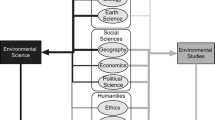Summary
Environmental studies has developed as an academic activity over the last 25 years. The area usually calls into play interdisciplinarity and the exploration of values. It also calls for inputs across a range of disparate sciences and humanities. Central to binding together these inputs are needs for commitment and communication between the cultures and philosophies involved.
Older and more traditional university cultures are not properly structured to permit the level of communication needed. Several models of environmental activities, and particularly their management, are described, together with their strengths and weaknesses. The lifeboat model as used at Griffith University is also described. This model indicates how the levels of communication can be enhanced by both major structural characteristics, as well as by more minor decisions like the allocation of offices.
Similar content being viewed by others
References
Dunlap, R.E., Gallup, G.H. Jr. and Gallup, A.M. 1992. The Health of the Planet Survey: A Preliminary Report on Attitudes toward the Environment and Economic Growth Measured by Surveys of Citizens in 22 Nations to Date. Paper read at the Annual Meetings of the International Association for Impact Assessment, Washington DC, 19–22 August.
Merton, R.K. 1964.Social Theory and Social Structure. The Free Press of Glencoe, Collier-Macmillan Ltd., London.
Milbrath, L.W. 1989.Envisioning a Sustainable Society. State University of New York Press, Albany, USA.
Rickson, R.E. and Rickson, S.T. 1982. Problems and prospects of cross disciplinary research.The Rural Sociologist,2, 95–104.
Saxberg, B.O., Newell, W.T. and Marr, B.W. 1986. Interdisciplinary research—a dilemma for university central administration. In: Chubin, D.E., Porter, A.L., Rossini, F.A. and Connolly, T. (eds),Interdisciplinary Analysis and Research, pp. 193–203. Lamond Publishers, Mt Airy. Maryland, USA.
UNESCO (1990), Environmental Education at a General Level in Tertiary Institutions of the Pacific Subregion.Proceedings of a Seminar and Workshops. Graduate School of the Environment, Macquarie University, Sydney, Australia.
Author information
Authors and Affiliations
Additional information
Their initial disciplines were in Mathematics and Computing, Sociology and Education respectively.
Rights and permissions
About this article
Cite this article
Braddock, R.D., Fien, J. & Rickson, R. Environmental studies: Managing the disciplinary divide. Environmentalist 14, 35–46 (1994). https://doi.org/10.1007/BF01902658
Issue Date:
DOI: https://doi.org/10.1007/BF01902658




